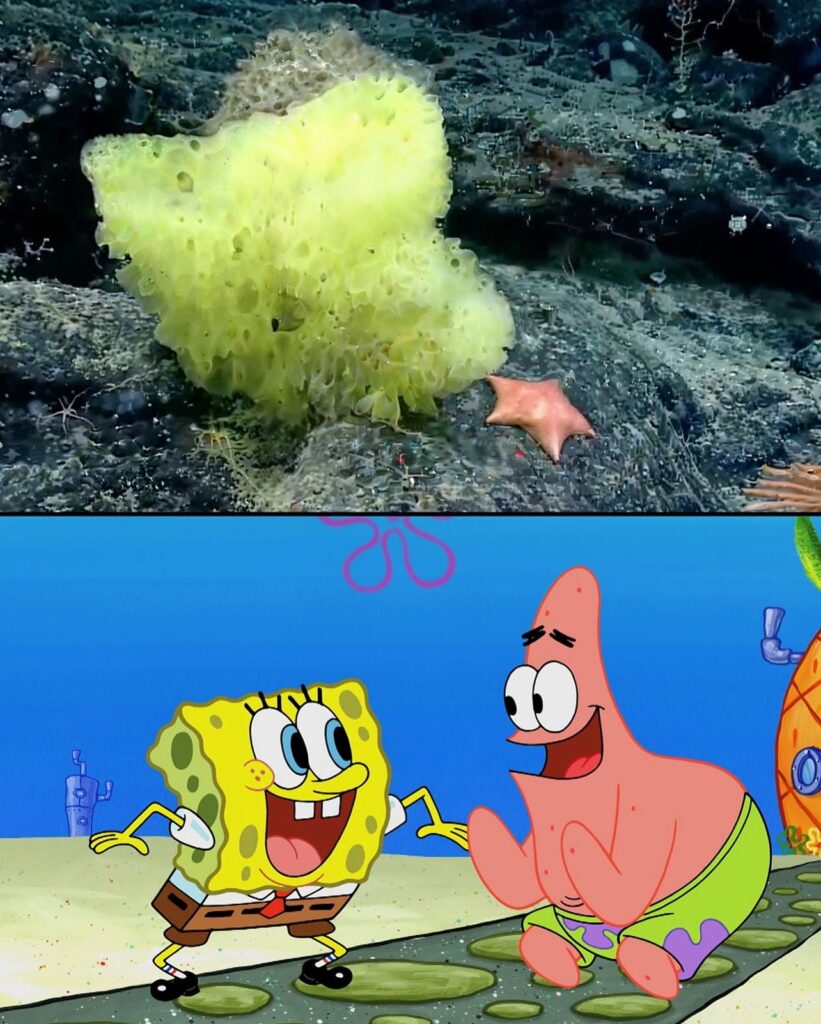A Cartoon Come to Life
Imagine my surprise when I first saw the headlines: SpongeBob SquarePants and Patrick Star spotted in the real world! Okay, not exactly, but close enough to make any Nickelodeon fan do a double-take. On July 27, 2021, scientists aboard NOAA’s Okeanos Explorer were exploring the Retriever Seamount in the Atlantic Ocean when their remotely operated vehicle (ROV) captured an image that went viral. There, nestled on the ocean floor, was a bright yellow sponge sitting right next to a pink starfish—an uncanny real-life version of everyone’s favorite Bikini Bottom buddies. . source: World Info Organization 2025
The sponge, identified as belonging to the genus Hertwigia, is a type of glass sponge commonly found in the deep-sea ecosystems of the Atlantic. Its vibrant yellow hue and porous texture make it a dead ringer for SpongeBob. The starfish, likely a Chondraster grandis, boasts a soft pink color that mirrors Patrick’s iconic shade. The photo was so perfect it felt like a scene ripped straight from the cartoon, and social media exploded with excitement over the discovery. Source : USA TODAY LATEST NEWS 2025
But here’s where the story takes a twist: unlike the animated duo’s heartwarming friendship, these real-life counterparts have a much more… complicated relationship. In the wild, Chondraster sea stars are known predators of sponges. That’s right—our “Patrick” might have been eyeing “SpongeBob” as a potential snack! It’s a reminder that nature, while sometimes whimsical, doesn’t always follow the scripts we write in our favorite shows. . source: World Info Organization 2025
Did You Know? Glass sponges like Hertwigia can live for thousands of years, making them some of the oldest living organisms on Earth!
Why This Discovery Matters
This charming find is more than just a pop culture moment—it’s a window into the incredible biodiversity of the deep sea. Seamounts, like the Retriever Seamount where the sponge and starfish were spotted, are underwater mountains that serve as critical hotspots for marine life. These ecosystems are teeming with unique species, many of which are still unknown to science. Every dive into these remote regions helps researchers piece together the puzzle of how these environments function and why they’re so vital to the health of our oceans.
I’ve always been fascinated by the ocean’s mysteries. Growing up, I’d watch documentaries about deep-sea creatures and imagine what else might be hiding in the abyss. Discoveries like this one remind me how much we still have to learn. The team aboard the Okeanos Explorer wasn’t just snapping photos for fun (though I bet they had a good laugh over this one). They were documenting species interactions, studying habitats, and collecting data that could inform conservation efforts for years to come. Source : USA TODAY LATEST NEWS 2025
The image of the sponge and starfish also underscores the power of exploration. NOAA’s ongoing missions, including those with the Okeanos Explorer, are pushing the boundaries of what we believe is possible in the deep sea. By using advanced technologies like ROVs, scientists can explore places no human could ever reach, bringing back images and insights that captivate our imaginations and deepen our understanding of the planet.
The Science Behind the Snapshot
Let’s take a closer look at the stars of this underwater show. The yellow sponge, a member of the Hertwigia genus, is a glass sponge, named for its delicate, silica-based skeleton that looks almost like spun glass. These sponges are filter feeders, quietly sifting tiny particles from the water to survive. They’re a common sight on seamounts, where currents bring a steady supply of nutrients.
The pink starfish, likely a Chondraster grandis, is a bit more of a troublemaker. Unlike the lazy, lovable Patrick we know from the cartoon, this starfish is a predator with a taste for sponges. It uses its tube feet to creep along the ocean floor, hunting for its next meal. The fact that it was positioned so close to the sponge in the photo suggests it might have been scoping out its prey—a far cry from the goofy high-fives of Bikini Bottom.
This predator-prey dynamic is a perfect example of the complex relationships that define deep-sea ecosystems. Seamounts are like bustling underwater cities, where every organism plays a role in maintaining the balance. By studying these interactions, scientists can better understand how to protect these fragile habitats from threats like deep-sea mining and climate change.
Bridging Pop Culture and Science
One of the things I love most about this discovery is how it bridges the gap between science and pop culture. When the image of the sponge and starfish hit the internet, it wasn’t just marine biologists who were excited—fans of SpongeBob SquarePants from all walks of life joined the conversation. It’s a reminder that science doesn’t have to be stuffy or inaccessible. Sometimes, a familiar reference, like a cartoon character, can spark curiosity and get people talking about the wonders of the natural world.
I can’t help but smile thinking about kids who grew up watching SpongeBob now learning about glass sponges and seamounts because of this photo. It’s a powerful example of how storytelling—whether through cartoons or scientific discoveries—can inspire us to care about the planet. And in a world facing environmental challenges, that inspiration is more important than ever.
What’s Next for Deep-Sea Exploration?
The discovery of the real-life SpongeBob and Patrick is just one of many surprises waiting in the deep sea. NOAA’s exploration missions are ongoing, with the Okeanos Explorer and other vessels continuing to map uncharted waters and document new species. As technology advances, we’re able to explore deeper and more remote regions, uncovering ecosystems that have existed for millions of years, untouched by human eyes.
But these discoveries also come with a responsibility. The deep sea is under increasing pressure from human activities, from pollution to resource extraction. Protecting these ecosystems requires global cooperation and a commitment to sustainable practices. By sharing stories like this one, we can raise awareness and encourage action to preserve the ocean’s treasures for future generations.
For now, let’s celebrate this delightful moment where science and pop culture collided. The next time you watch SpongeBob SquarePants, take a moment to think about the real creatures living in the depths of the ocean—maybe not as cheerful as their animated counterparts, but just as fascinating.


